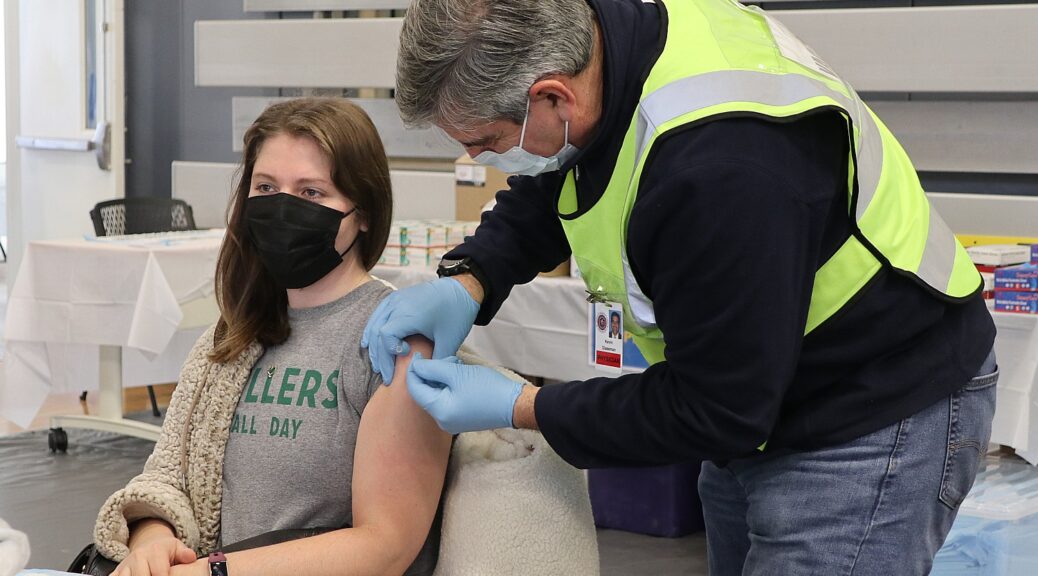
The June 2023 jobs report showed 497,000 more jobs created last month (twice the number anticipated) and wages up 6.4% – both indications of a strong, resilient economy and that ordinary, working Americans are doing well. Nonetheless, the stock market fell sharply over fears the Federal Reserve would continue to hike interest rates in order to tame the demon inflation by causing the labor market to weaken and take the steam out of wage growth. But the stock market is not the economy Americans live every day.
The Bidenomics agenda is driving investments in communities across the country – like billions of dollars for states to connect every American to high-speed internet, investments to rebuild roads and bridges, and investments to build a clean energy economy, boost domestic manufacturing, create jobs and lower costs for the American people.
Meanwhile, Republicans who voted against the historic investments of the Bipartisan Infrastructure Act and all efforts by the Biden Administration to promote a sustainable, resilient economic recovery that benefits all Americans, are actually, cynically, hypocritically taking credit for the marvelous infrastructure improvements like broadband and bridges, in their communities.
Despite GOP “voting no but still wanting the dough,” the Biden-Harris Administration is continuing to deliver investments, lower costs, and opportunity to hardworking Americans in every corner of the country.
In remarks in Chicago on June 28, President Biden declared, “Today, the U.S. has had the highest economic growth among the world’s leading economies since the pandemic. We’ve added over 13 million jobs, more jobs in two years than any President has added in a four-year term.
“And folks, that’s no accident. That’s Bidenomics in action.
“Bidenomics is about building the economy from the middle out and bottom up – not the top down by making three fundamental changes.
“First, making smart investments in America. Second, educating and empowering American workers to grow the middle class. And third, promoting competition to lower costs and help small businesses.”
The White House provided this fact sheet outlining how Bidenomics is indeed working, giving the U.S. the strongest economy among the G7, and growing the economy sustainably, from the middle out and the bottom up, rather than the top-down “trickle down” con the Republicans have been hawking since Reagan.—Karen Rubin/news-photos-features.com
President Biden and Vice President Harris came into office determined to rebuild our economy from the middle out and the bottom up, not the top down—and that strategy is working. Even as they faced an immediate economic and public health crisis—with a raging pandemic, elevated unemployment, snarled supply chains, and hundreds of thousands of small businesses at risk of shuttering—the President and Vice President understood that it wouldn’t be enough to simply go back to the economy we had before the pandemic. That economy was saddled with longstanding challenges that held America back—including rising inequality and disinvestment from communities across the country.
President Biden recognized that some of those challenges were rooted in a failed trickle-down theory that supported slashing taxes for the wealthy and big corporations, shrinking public investment in critical priorities like infrastructure and education, and failing to safeguard market competition.
The President took office determined to move beyond these failed trickle-down policies and fundamentally change the economic direction of our country. His plan—Bidenomics—is rooted in the recognition that the best way to grow the economy is from the middle out and the bottom up. It’s an economic vision centered around three key pillars:
- Making smart public investments in America
- Empowering and educating workers to grow the middle class
- Promoting competition to lower costs and help entrepreneurs and small businesses thrive
While our work isn’t finished, Bidenomics is already delivering for the American people. Our economy has added more than 13 million jobs—including nearly 800,000 manufacturing jobs—and we’ve unleashed a manufacturing and clean energy boom. There were more than 10 million applications for new small businesses filed in 2021 and 2022—the strongest two years on record. America has seen the strongest growth since the pandemic of any leading economy in the world. Inflation has fallen for 11 straight months and has come down by more than half. And we have done it all while responsibly reducing the deficit.
None of this progress was an accident or inevitable—it has been a direct result of Bidenomics. And rather than taking us back to the failed trickle-down policies of the past, President Biden is committed to finishing the job and continuing to build an economy that finally works for working families—with better jobs, lower costs, and more opportunity.
Building More in America by Making Smart Public Investments
When President Biden came into office, public investment as a share of the economy had fallen from 7% in the 1960s to half that. A core tenet of Bidenomics is that targeted public investment can attract more private sector investment, rather than crowd it out. This is particularly true in sectors that are central to the long-term economic and national security interests of the United States—from improving our infrastructure, to semiconductors, to investing in clean energy and climate security.
The Biden-Harris Investing in America agenda is rebuilding our infrastructure, including our roads and bridges, high-speed internet capacity, ports, and airports. This infrastructure is the necessary foundation for durable and shared economic growth. Thanks to the Bipartisan Infrastructure Law, 35,000 new projects have been awarded funding in communities all across the country. By requiring Made-in-America products when using federal funding to rebuild infrastructure, President Biden is not only investing in our country’s roads and bridges, but also a strong domestic manufacturing base.
The President’s agenda is also investing in key industries that are critical to our national security and economic security, like producing more semiconductors in America. And it is investing in accelerating the clean energy economy to help achieve our climate goals, working with our global partners. This approach is creating millions of good-paying jobs, advancing American leadership in innovating next-generation technologies, and delivering for workers and communities. The President’s agenda is strengthening our clean energy supply chains by spurring new and expanded U.S. factories, including more than 150 battery plants and 50 solar plants already announced. In all, we’ve seen $490 billion in private investment commitments in 21st century industries since the President took office, and inflation-adjusted manufacturing construction spending has grown by nearly 100% in just two years. New data released just today shows the clean energy workforce added nearly 300,000 jobs in 2022 and clean energy jobs grew in every state in America, in part because of the investments in clean energy and manufacturing by the Biden-Harris Administration.
Empowering and Educating Workers to Grow the Middle Class
Bidenomics also recognizes that the benefits of a growing economy are only broadly shared when policies are designed to promote and empower workers. When the President took office, independent experts like the Congressional Budget Office were projecting that the unemployment rate wouldn’t fall below 4% until the end of 2025. But under Bidenomics, the unemployment rate fell below 4% four years before expectations and has stayed there for the past 18 months.
We’ve also seen record lows in unemployment for workers who have often been left behind in previous recoveries: with record low unemployment rates achieved under this Administration for African Americans, Hispanic Americans, and people with disabilities—and a 70-year low for women. This strong labor market recovery has also led to better pay and working conditions. Inflation-adjusted income is up 3.5% since the President took office, and low-wage workers have seen the largest wage gains over the last year. Job satisfaction reached its highest level on record last year. And the prospect of good jobs has drawn people off the sidelines and into the workforce. In fact, the share of working-age Americans in the workforce hasn’t been higher in more than 20 years. This strong recovery will also provide durable benefits for years to come, in part by preventing the labor market scarring that sticks with workers for generations after a recession.
Empowering workers also means educating America’s workers—those with and without a four-year degree. That’s why the Biden-Harris Administration is investing more in registered apprenticeships and career technical education programs than any previous Administration and continuing to fight for free universal pre-K and free community college.
And the President believes a critical tool for empowering workers is making it easier to join a union. The President is addressing a decades-long decline in unionization by supporting project labor agreements and collective bargaining. He asked the Vice President to lead the White House Task Force on Worker Organizing and Empowerment to drive action across the Administration to empower workers and support their right to join or form a union. Support for unions is the highest it’s been in more than half a century, and the labor movement is expanding to new companies and industries.
Promoting Competition to Lower Costs and Help Entrepreneurs and Small Businesses Thrive
Bidenomics recognizes that for markets to function—and for workers and consumers to benefit—our economy requires healthy competition across sectors. After three-quarters of U.S. industries grew more concentrated in the two decades before President Biden took office, he understood that we needed a different approach. More competition means lower costs for consumers and higher wages for workers. And since taking office, the President has been delivering for the American people to lower prices, protect workers, and increase competition across the economy.
When the President took office, he signed an historic Executive Order on Competition, which “commits the federal government to full and aggressive enforcement of our antitrust laws.” That order identified 72 specific initiatives across government to promote competition—and it is paying off. In addition to enforcement, the Administration is lowering costs for consumers and creating opportunities for innovative new products to come to market—including from the millions of new small businesses around the country that have started during the Biden-Harris Administration.
For example, the Administration changed the rules so that hearing aids can be sold over-the-counter, instead of just via prescription. Previously, hearings aids could cost up to $5,000 per pair, but Americans can now get them for a few hundred dollars at a local convenience or electronics store. President Biden has signed legislation into law that will lower prescription drug costs for seniors and save taxpayers $160 billion over the next decade by giving Medicare the authority to negotiate lower prescription drug prices. The Administration is also fighting to end junk fees—hidden charges that cost Americans’ tens of billions per year and rob the marketplace of the kind of transparency that is necessary for real competition. And the Administration is working toward cracking down on noncompete agreements, which currently limit as many as 30 million workers from switching to a new job in the same field.
Reducing the Deficit and Making the Wealthy and Big Corporations Pay Their Fair Share
President Biden has pursued this economic vision in a fiscally responsible way—in stark contrast to the Congressional Republican approach. His predecessor enacted the latest version of trickle-down and the result was predictable: his tax giveaway added trillions to deficits, never trickled down to workers, and led to continued offshoring of jobs and profits. In recent weeks, House Republicans have doubled down on this approach—rolling out proposals to enact massive tax cuts for large corporations, including oil companies that made $200 billion in profit last year, while setting the stage for trillions in tax cuts skewed to the wealthiest Americans, delivering a $175,000 average annual tax cut to the top 0.1% (incomes over $4 million). Their view of “fiscal responsibility” is massive cuts to programs that millions of Americans count on, with the Republican Study Committee—which speaks for more than three quarters of House Republicans—recently releasing a plan to raise the Social Security retirement age to 69, eliminate the Medicare prescription drug savings that President Biden has signed into law, raise premiums for seniors on Medicare, and slash Medicaid, the Affordable Care Act, food assistance, and Pell Grants.
President Biden believes in a fundamentally different approach. Under Bidenomics, he has proven that we can make smart investments in the American people while reducing the deficit by ensuring the wealthy and large corporations pay their fair share in taxes, closing wasteful tax loopholes, and slashing wasteful spending on special interests.
During his first two years, the President presided over $1.7 trillion in deficit reduction—a larger reduction than under any other President in American history. He has signed legislation into law to reduce the deficit by more than $1 trillion over the next decade, including by ensuring the wealthiest Americans and largest corporations pay their fair share, cracking down on wealthy tax cheats, and lowering prescription drug costs for the American people by cutting wasteful giveaways to Big Pharma. And his Budget would reduce the deficit by another more than $2.5 trillion over the next decade with additional reforms, including requiring the wealthiest Americans and the largest multinational corporations to pay at least the tax rates that many middle-class families do.
Unlike House Republicans—whose plans would harm hard-working families—the President has proposed cutting taxes for working people and families with children by almost $800 billion over the next 10 years, including cutting taxes by an average of $2,600 for 39 million families that include 62 million children by expanding the Child Tax Credit, cutting taxes by an average of $800 for 19 million working individuals or couples by expanding the Earned Income Tax Credit, and continuing Premium Tax Credit plus-ups that are cutting health care premiums by an average of $800 for nearly 15 million people.

















